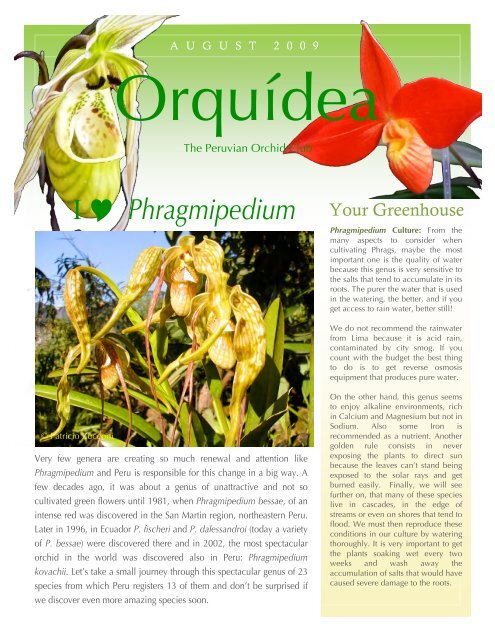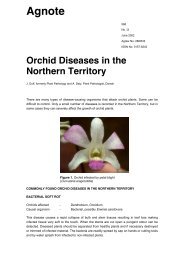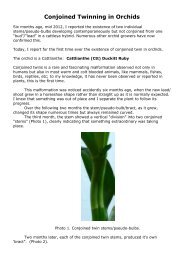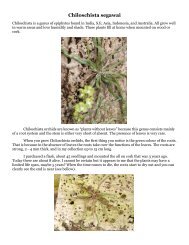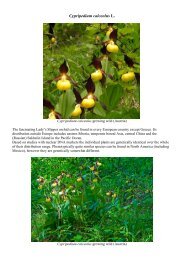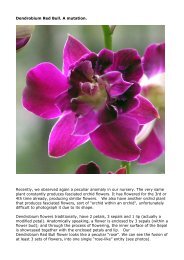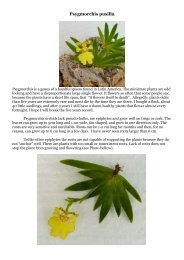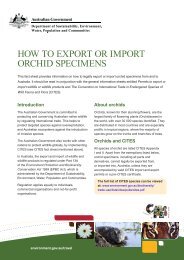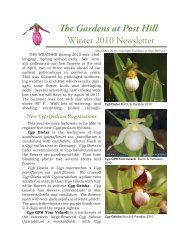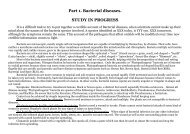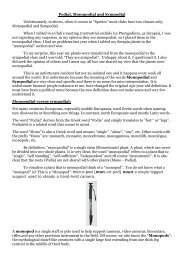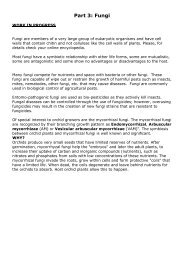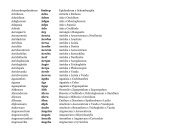Orquidea, August 2009 | The Peruvian Orchid Club ... - Orchids-World
Orquidea, August 2009 | The Peruvian Orchid Club ... - Orchids-World
Orquidea, August 2009 | The Peruvian Orchid Club ... - Orchids-World
You also want an ePaper? Increase the reach of your titles
YUMPU automatically turns print PDFs into web optimized ePapers that Google loves.
A U G U S T 2 0 0 9<br />
Orquídea<br />
<strong>The</strong> <strong>Peruvian</strong> <strong>Orchid</strong> <strong>Club</strong><br />
I Phragmipedium<br />
Your Greenhouse<br />
Phragmipedium Culture: From the<br />
many aspects to consider when<br />
cultivating Phrags, maybe the most<br />
important one is the quality of water<br />
because this genus is very sensitive to<br />
the salts that tend to accumulate in its<br />
roots. <strong>The</strong> purer the water that is used<br />
in the watering, the better, and if you<br />
get access to rain water, better still!<br />
We do not recommend the rainwater<br />
from Lima because it is acid rain,<br />
contaminated by city smog. If you<br />
count with the budget the best thing<br />
to do is to get reverse osmosis<br />
equipment that produces pure water.<br />
© Patricio Zucconi<br />
Very few genera are creating so much renewal and attention like<br />
Phragmipedium and Peru is responsible for this change in a big way. A<br />
few decades ago, it was about a genus of unattractive and not so<br />
cultivated green flowers until 1981, when Phragmipedium bessae, of an<br />
intense red was discovered in the San Martin region, northeastern Peru.<br />
Later in 1996, in Ecuador P. fischeri and P. dalessandroi (today a variety<br />
of P. bessae) were discovered there and in 2002, the most spectacular<br />
orchid in the world was discovered also in Peru: Phragmipedium<br />
kovachii. Let’s take a small journey through this spectacular genus of 23<br />
species from which Peru registers 13 of them and don’t be surprised if<br />
we discover even more amazing species soon.<br />
On the other hand, this genus seems<br />
to enjoy alkaline environments, rich<br />
in Calcium and Magnesium but not in<br />
Sodium. Also some Iron is<br />
recommended as a nutrient. Another<br />
golden rule consists in never<br />
exposing the plants to direct sun<br />
because the leaves can’t stand being<br />
exposed to the solar rays and get<br />
burned easily. Finally, we will see<br />
further on, that many of these species<br />
live in cascades, in the edge of<br />
streams or even on shores that tend to<br />
flood. We must then reproduce these<br />
conditions in our culture by watering<br />
thoroughly. It is very important to get<br />
the plants soaking wet every two<br />
weeks and wash away the<br />
accumulation of salts that would have<br />
caused severe damage to the roots.
ORQUÍDEA<br />
<strong>The</strong> genus Phragmipedium<br />
This genus is known to occur from Mexico to Bolivia and up to 1989 it<br />
was not really appreciated by cultivators. However, after the entire genus<br />
was incorporated in the appendix I of the CITES agreement for the<br />
conservation of species in danger of extinction, the interest for this genus<br />
increased. Before this surprising response only four species were<br />
considered interesting for cultivation: Phragmipedium bessae,<br />
Phragmipedium caudatum, Phragmipedium lindenii and Phragmipedium<br />
schlimii. From these four species, the first three occur in Peru and the last<br />
one in Colombia. <strong>The</strong> taxonomy of this genus is not stable yet. For<br />
example, some consider the varieties of Phragmipedium caudatum,<br />
Phragmipedium wallisii and Pragmipedium warscewiczianum as species.<br />
This new interest in Phragmipedium is generating a new set of hybrids<br />
and a big international demand for the species and their grexes. Some<br />
experts speculate that it is just matter of time to discover a new species of<br />
a shade between pink and magenta (dark pink) in one of our countries,<br />
and we hope it is Peru, and this time be discovered by a responsible<br />
<strong>Peruvian</strong> that will report, register, and protect it respecting the proper<br />
procedures.<br />
AUGUST <strong>2009</strong><br />
<strong>Peruvian</strong> Phragmipediums<br />
• P. besseae Dodson & J. Kuhn 1981<br />
• P. boisserianum (Reichb.f.) Rolfe 1896<br />
• P. boissierianum var. czerwiakowianum<br />
(Rchb.f.) O.Gruss 1995<br />
• P. caricinum (Lindl. & Paxton) Rolfe 1896<br />
• P. caudatum (Lindl.) Rolfe 1896<br />
• P. kovachii .Atwood, Dalström & Fernández 2002<br />
• P. lindenii (Lindl.) Dressler & N.H.Williams 1975<br />
• P. longifolium (Warsz. & Rchb.f.) Rolfe 1896<br />
• P. pearcei (Reichb.f.) Rauh & Senghas 1896<br />
• P. reticulatum (Reichb.f.) Garay 1921<br />
• P. richteri Roeth & O.Gruss 1994<br />
• P. warszewiczianum (Rchb.f.) Schltr. 1922<br />
© Isaías Rolando
ORQUÍDEA<br />
AUGUST <strong>2009</strong><br />
Phragmipedium bessae Dodson & J. Kuhn 1981<br />
<strong>The</strong> real reason of the re-born interest in the genus<br />
Phragmipedium, P. bessae, was discovered in the<br />
route between Tarapoto and Yurimaguas, in the<br />
San Martin region as a lithophyte growing on<br />
humid granite at an altitude of 1,100 meters. It was<br />
named in honor of Elizabeth Lock Besse, a<br />
benefactor of the Marie Selby Botanical Gardens<br />
who discovered the species while accompanying a<br />
botanical expedition in our country, Peru. In 1984,<br />
C.H. Dodson discovered a second population in<br />
the Guarumales dam, close to Paule, in Ecuador. In<br />
1985, Dennis D’Alessandro discovered a third<br />
population in the highlands of Zamora, also in<br />
Ecuador. This last population is characterized for<br />
having a yellower shade with shorter<br />
inflorescences. <strong>The</strong> specimens of this population<br />
are called the dalessandroi variety. P. bessae<br />
belongs to the Micropetalum section next to P.<br />
andreettae, P. dallesandroi, P. fischeri, P. kovachii,<br />
and P. schlimii. <strong>The</strong>re is a possibility that there will<br />
be a change of name in this section soon thanks to<br />
the big flower of P. kovachii.<br />
© Susi Spitler<br />
After its discovery, the original<br />
population of P. bessae in Peru<br />
was collected almost up to<br />
extinction. That red color had<br />
only been seen before in Disa<br />
uniflora in South African<br />
cascades! Luckily, it has been<br />
recently confirmed that the<br />
species is recovering in its<br />
original habitat.<br />
© Isaías Rolando<br />
Here we can see two pictures<br />
that show the differences<br />
between the <strong>Peruvian</strong> and<br />
Ecuadorian varieties. <strong>The</strong><br />
<strong>Peruvian</strong> variety presents oval<br />
shapes and more intense red<br />
shades. <strong>The</strong> Ecuadorian variety<br />
is usually elongated and more<br />
of an orange shade. P. bessae<br />
also comes in a beautiful<br />
yellow form known as flava.
ORQUÍDEA<br />
AUGUST <strong>2009</strong><br />
Subsequently big populations<br />
of P. bessae have been found<br />
in Ecuador. Harold<br />
Kopowitz, who has studied<br />
these populations, suggests<br />
that the intensity of the red<br />
shades has more to do with<br />
the type of nutrition, the<br />
light, and the general<br />
development of the plant<br />
than with the geographical<br />
origin of the population.<br />
Orange, yellow, and even<br />
pink shades have been<br />
verified but white albino<br />
forms have become up to<br />
date part of urban legends.<br />
<strong>The</strong> substance that generates<br />
those purple-pink tones are<br />
called anthocyanines and are<br />
found in the superior layer of<br />
the flower or epithelium,<br />
lying on a thicker tissue<br />
made of several layers of<br />
cells composed at the same<br />
time by carotenoid pigments<br />
of yellow color. This<br />
superposition of layers<br />
generates in P. bessae the<br />
characteristically orange<br />
tone.<br />
<strong>The</strong> flava forms are simply<br />
plants with mutations that<br />
cannot express the<br />
anthocyanine as a pigment,<br />
with the result of a<br />
transparent epithelium that<br />
allows the yellow tone of the<br />
inferior carotenoid layers to<br />
be translucent.<br />
© Pablo Bermúdez<br />
Most important Phragmipedium bessae hybrids:<br />
Phragmipedium bessae x Phragmipedium bessae x<br />
Phrag. boissierianum = Lutz Rölke Phrag. richteri = Franz Glanz<br />
Phrag. caricinum = Mary Bess<br />
Phrag. sargentianum = Memoria Dick<br />
Clements<br />
Phrag. caudatum = Ruby Slippers Phrag. schlimii = Hanne Popow<br />
Phrag. czerwiakonianum = Robert Palm Phrag. vittatum = Vittabess<br />
Phrag. dallessandroi = Jersey<br />
Phrag. wallissii = María Glanz<br />
Phrag. ecuadorense = Ecua-Bess Phrag. warzcewiczianum = Super Rubies<br />
Phrag. fischeri = Barbara LeAnn<br />
Phrag. kaieterum = Rosalie Dixter<br />
Phrag. klotscheanum = Will Chantry<br />
Phrag. lindleyanum = Andean Fire<br />
Phrag. longifolium = Eric Young<br />
Phrag. pearcei = Olaf Gruss<br />
An additional note about P. bessae and P. dallessandroi: when the chromosome count was made for these<br />
species, P. bessae showed 2n=24, and P. dallessandroi 2n=28; however they are treated as a varieties and not<br />
as different species although they show distinctive characteristics in their growth and general morphology.<br />
Since 2004, the grexes generated with P. dallessandroi have been accepted as valid and differentiated from<br />
those generated with P. bessae.
ORQUÍDEA<br />
AUGUST <strong>2009</strong><br />
© Isaías Rolando<br />
In this picture we can<br />
appreciate the <strong>Peruvian</strong><br />
variety, on the lower<br />
photo, the Ecuadorian<br />
variety with narrower<br />
petals and a more intense<br />
tone of orange. Next to it<br />
the flava variety of an<br />
Ecuadorian form of P.<br />
bessae.<br />
It is estimated that P.<br />
bessae grows between<br />
1,000 and 1,500 meters<br />
high. In its natural<br />
environment it can be<br />
found close to streams and<br />
waterfalls in cool<br />
temperature, under dapper<br />
light but never under<br />
direct sun. As with any<br />
Phragmipedium, they need<br />
pure water and a<br />
constantly humid growing<br />
medium.<br />
As with most Phragmipediums, it is highly recommended to use a growing medium rich in pulverized<br />
limestone and fertilize with Calcium and Magnesium. It is fundamental to water regularly with pure<br />
water after fertilizing to avoid the accumulation of salts in the roots. P. bessae is vastly crossed to do<br />
hybrids. It is considered an endangered species in nature.<br />
© Pablo Bermúdez © Eric Hunt
ORQUÍDEA<br />
AUGUST <strong>2009</strong><br />
Phragmipedium caudatum (Lindl.) Rolfe 1896<br />
If we measure the full<br />
size of the flower<br />
including its long<br />
cauda, P. caudatum is<br />
with no doubt the<br />
biggest flower of all<br />
orchids, sometimes<br />
reaching over a meter<br />
long.<br />
But the rest of the<br />
flower is also pretty big<br />
and if it wasn’t<br />
enough, this attractive<br />
species presents<br />
varieties that make it<br />
even more interesting<br />
because it presents a<br />
wide range of shades<br />
and tones.<br />
It is a species<br />
commonly used for<br />
hybridization.<br />
Although it was also<br />
registered, as is the<br />
case of P. bessae, in<br />
the Appendix I of the<br />
CITES Agreement for<br />
the protection of<br />
natural species, is very<br />
common in our<br />
country.<br />
Foto© Pablo Bermúdez<br />
© Patricio Zucconi<br />
Foto© Eric Hunt
ORQUÍDEA<br />
AUGUST <strong>2009</strong><br />
© Pablo Bermúdez
ORQUÍDEA<br />
AUGUST <strong>2009</strong><br />
Most important Phragmipedium caudatum hybrids:<br />
Phragmipedium caudatum x Phragmipedium caudatum x<br />
Phrag. bessae = Ruby Slippers<br />
Phrag. schlimii = Saundersianum<br />
Phrag. boissierianum = Court Jester<br />
Phrag. wallissii = Tall Tails<br />
Phrag. caricinum = Dominianum<br />
Phrag. warscewizianum = Majestic Tresses<br />
Phrag. dallessandroi = Coffee Break<br />
Phrag. ecuadorense = Toyoki Kawatsura<br />
Phrag. exstaminodium = Memoria Julius Dixler<br />
Phrag. lindenii = Mauricianum<br />
Phrag. lindleyanum = Geralda<br />
Phrag. longifolium = Grande<br />
Phrag. pearcei = Betheva
ORQUÍDEA<br />
AUGUST <strong>2009</strong><br />
Phragmipedium caudatum is a species that has been found to grow terrestrially, lithophytically and<br />
epiphytically in Mexico, Guatemala, Panama, Venezuela, Colombia, Ecuador, Peru and Bolivia. In our<br />
country, it can be found in Amazonas, San Martin, Cerro de Pasco and Cuzco between 1,800 and the 2,600<br />
meters high. It is a strong caespitose of warm to cool weather. It can be found in open fields, grassy slopes, cliff<br />
faces, shady jungles and humus soil, tree trunks and branches from the trees; anyway, its capacity to adapt to<br />
different environments is amazing. Its flowers present also a wide range of tones and shades, from the very<br />
light yellows, to dark browns like the variety that can be found in Cerro de Pasco. <strong>The</strong> flowers bloom<br />
simultaneously from a large inflorescence and display very large cauda of coffee or violet colors that can<br />
exceed one meter in length. It is not known whether the cauda are used by insects to climb up to pollinate the<br />
flowers or if they have actually been designed by nature to attract the pollinators as they dance in the wind.<br />
Another task we have ahead we who have its habitat at hand: identify its pollinators.<br />
This species has two varieties P. caudatum var. wallisii and P. caudatum var. varsceviczianum. This last one<br />
seemed to have been recently elevated to the rank of species by the Monocot <strong>World</strong> Checklist published by<br />
the Royal Botanic Gardens of Kew as Phragmipedium warszewiczianum (Rchb.f.) Schltr. 1922, distinguishing it<br />
from the central American variety named Phragmipedium warszewiczii (Rchb.f.) Christenson 2006, which is<br />
reported for Costa Rica, Guatemala and Panama.<br />
Phragmipedium warszewiczianum has been reported only for Colombia and Ecuador but we were able to see<br />
it in more than one opportunity in Peru with that very dark burgundy pouch. <strong>The</strong> original species as its<br />
varieties belong to the Phragmipedium section next to P. extaminodium and P. lindenii.<br />
P. caudatum var. warszewiczianum © Pablo Bermúdez
ORQUÍDEA<br />
AUGUST <strong>2009</strong><br />
© Erica Morón
ORQUÍDEA<br />
AUGUST <strong>2009</strong><br />
Phragmipedium caudatum var. wallisii (Rchb.f.) Garay 1978<br />
© Pablo Bermúdez<br />
This species is so far,<br />
recognized as a variety<br />
of Phrag. caudatum. It<br />
is smaller, clearer and<br />
common to Colombia,<br />
Ecuador and Peru and<br />
occupies the same<br />
ecological strata. In<br />
particular, the edge of<br />
the lips is of a whitebone<br />
color.<br />
With respect to the<br />
cultivation of both<br />
varieties, the most<br />
important factor is to<br />
keep the medium<br />
always moist and if<br />
possible use very pure<br />
water.<br />
We recommend a mix<br />
rich in limestone,<br />
sphagnum moss and<br />
perlite to allow good<br />
ventilation. Some<br />
growers keep their<br />
Phrag. caudatum<br />
plants always on trays<br />
with water to keep the<br />
roots always wet.<br />
Other people put pots<br />
inside bigger pots filled<br />
with constantly humid<br />
moss. This technique<br />
seems to have very<br />
good results<br />
particularly with<br />
species of cool<br />
climates. Well, we<br />
leave it up to you to try<br />
these techniques.
ORQUÍDEA<br />
AUGUST <strong>2009</strong><br />
© Pablo Bermúdez
ORQUÍDEA<br />
AUGUST <strong>2009</strong><br />
Phragmipedium lindenii (Lindl.) Rolfe 1896<br />
This strange species is the only Phragmipedium with an open pouch or labellum. It all indicates that it was an<br />
unusual mutation, a peloric form of P. caudatum because the labellum is a floral structure that fulfills a<br />
fundamental function acting as a guide by the pollinator. In this case the pouch was replaced by a large petal<br />
that ends in a large cauda that is accompanied by two other large petals similar to the ones from P. caudatum,<br />
although, the staminodium is also different to the one in P. caudatum and similar to the one in P. caudatum<br />
var. wallisii. In addition, it also presents a third fertile anther.<br />
<strong>The</strong>se features allowed P. lindenii to be classified as a species. On a different note, it seems that a recessive<br />
gene generates the absence of the pouch because all the hybrids made up to date with P. lindenii present the<br />
characteristic and complete round labellum common to P. caudatum. <strong>The</strong> species can be found in Venezuela,<br />
Colombia, Ecuador and Peru where it has been reported in San Martin (High Saposoa) and Pasco (Oxapampa).<br />
It grows in tropical moist and humid mountain forests between 1,200 and 2,850 meters high in gravel, granite<br />
rock, or humus or constantly humid moss and as an epiphyte it has been reported on secondary branches of<br />
red cedar, Moena trees and even on rotten stumps. As with every Phragmipedium it is recommended to water<br />
this species with pure water with a pH of 7.5 or less not letting the medium to dry. Some growers put the pots<br />
on trays filled with water. This is good technique, but the water must always run through the plant. Do not<br />
water the plant through the tray.<br />
© Eric Hunt
ORQUÍDEA<br />
AUGUST <strong>2009</strong><br />
© Pablo Bermúdez
ORQUÍDEA<br />
AUGUST <strong>2009</strong><br />
Phragmipedium boissierianum (Rchb. f.) Rolfe 1896<br />
Named in honor of the Swiss explorer and botanist Pierre Edmond Boissie, this terrestrial species, close to<br />
Phragmipedium longifolium, is found in Peru and Ecuador at elevations of 400 to 1,570 meters.<br />
In Peru it has been registered in Cajamarca (San Ignacio, 1300m.), San Martin (San Martin 600 m., Rioja 1170<br />
m.), Huánuco (Leoncio Prado, 1310 – 1570m.) and Ucayali (860 m.). It grows in very humid wet montane<br />
forests, usually on the southeast faces of cliffs with water seepages. It is also common to find them on slopes<br />
covered with pastures on the edge of jungles.<br />
As in the case of Phragmipedium longifolium, it is common for these species to colonize the sides of roads in big<br />
populations that take advantage of these artificial clearings, and is also common for these plants to self pollinate<br />
themselves what would explain these big populations.<br />
<strong>The</strong>se are medium size plants, of warm to cool weather. <strong>The</strong>y produce from 3 to 15 consecutive big flowers that<br />
can measure over 17 cm in length (including the cauda) that bloom from fall to spring. It is characteristic of this<br />
species to have lips with curled and wavy edges. <strong>The</strong> margins of the dorsal sepal also present this waviness.<br />
<strong>The</strong>se species are rarely used in hybridization, but the few existing hybrids are very important like Phrag. Court<br />
Jester (with Phrag. caudatum), Phrag. Lutz Rolke (with Phrag. bessae) and Phrag Praying Mantis (with Phrag.<br />
longifolium).<br />
Phragmipedium boissierianum belongs to the Lorifolia section with P. hirtzii, P. longifolium and P. vittatum. <strong>The</strong><br />
following picture was taken by our fellow member and great photographer, Erica Moron de Abad in the natural<br />
habitat of Phragmipedium boissieranum.
ORQUÍDEA<br />
AUGUST <strong>2009</strong><br />
Most important Phragmipedium boissierianum hybrids:<br />
Phragmipedium boissierianum x Phragmipedium czerwiakonianum x<br />
Phrag. bessae = Lutz Rölke<br />
Phrag. bessae = Robert Palm<br />
Phrag. caudatum = Court Jester<br />
Phrag. caudatum = Coffee Break<br />
Phrag. longifolium = Praying Mantis<br />
Phrag. lindleyanum = Dana Hutchinson<br />
Phrag. pearcei = Taras<br />
Phrag. longifolium = Denis Kleinbach<br />
Phrag. schlimii = Harbinger’s Grasshoper<br />
Phrag. schlimii = Silver Eagle<br />
Phrag. wallisii = Green Ghost<br />
© Frank Hajek
ORQUÍDEA<br />
AUGUST <strong>2009</strong><br />
Phragmipedium longifolium (Warsz. & Rchb.f.) Rolfe 1896<br />
One of the best known species of Phragmipedium in the world is, bizarrely, not so common in Peru where it<br />
can only be found to the very extreme north of the country, in wild and vaguely populated areas. We are<br />
talking about the most used species in hybridization, as it is a strong plant that produces long flower stems<br />
with big consecutive flowers. This species can be found from Mexico to Peru (San Martin) at elevations of 50<br />
to 2,000 meters, as a species of warm to cool weather. It grows in different habitats, mainly in humid forests,<br />
as terrestrial or lithophyte, where it can be seen growing in fields of constantly moist clay, in the vicinity of<br />
rivers, seepage areas and moss covered cliffs. It is a very variable species, both in size as in the shape of the<br />
flower, with at least one alba form. It is a strong and very easy to grow plant, as long as we respect the basic<br />
rules of Phragmipedium growth.<br />
<strong>The</strong> roots are very long and pubescent, and the inflorescences can be very long also, surpassing over one<br />
meter and producing a series of consecutive flowers. We have been lucky enough to see them grow in<br />
nature, in an ample slope of clay where thick rhizomes of big plants expanded though wet mud from where<br />
new sprouts came out while other flowers were being naturally pollinated. <strong>The</strong>y grew side by side with big<br />
scrubs of Sobralia rosea by the thousands… a sight of nature worth watching! <strong>The</strong> next photograph illustrates<br />
one of these plants taken in its natural habitat.<br />
© Pablo Bermúdez
ORQUÍDEA<br />
AUGUST <strong>2009</strong><br />
© Pablo Bermúdez
ORQUÍDEA<br />
AUGUST <strong>2009</strong><br />
Phragmipedium pearcei (Rchb. f.) Rauh & Senghas 1975<br />
This small terrestrial and lithophyte species of warm to cold climates can be found in Ecuador and Peru<br />
(San Martin) at elevations from 300 to 1,700 meters. It grows in the form of dense bushes united<br />
between them by rhizomes of up to 10 cm of length that many times tend to extend in the form of<br />
pubescent arms around the ground generating several simultaneously new sprouts. <strong>The</strong> leaves look like<br />
fine grass with which they can get confused. This species can also be found growing on steep<br />
embankments. <strong>The</strong> leaves do not grow beyond 20 cm in length and 1 cm of width. <strong>The</strong>y usually grow in<br />
the vicinity of rivers and streams or in gravel banks that to flood periodically.<br />
<strong>The</strong> areas where they grow usually receive direct sun but not these small orchids, which are usually<br />
protected by the surrounding vegetation. <strong>The</strong> inflorescence is erect, up to 15 cm long, multi-floral,<br />
producing many flowers in several simultaneous inflorescences. <strong>The</strong>y bloom in the summer with<br />
unscented flowers of short life. <strong>The</strong> staminodium is from oval to heart shape and presents on its base<br />
long and hard hairs except in the middle, making it look like eyebrows. <strong>The</strong> lip is clearly marked by<br />
veins. P. pearcei belongs to the Himantopetalum section with P. caricinum, P. klotscheanum, P.<br />
lindleyanum, and P. richteri.<br />
© Walter Pinochet
ORQUÍDEA<br />
AUGUST <strong>2009</strong><br />
© Frank Hajek
ORQUÍDEA<br />
AUGUST <strong>2009</strong><br />
© Pablo Bermúdez<br />
Most important Phragmipedium pearcei hybrids:<br />
Phragmipedium pearcei x<br />
Phrag. bessae = Olaf Gruss<br />
Phrag. boissierianum = Taras<br />
Phrag. dallessandroi = Petit Anquette<br />
Phrag. longifolium = Green Hornet<br />
Phrag. schlimii = Carol Kanzer<br />
Phrag. wallissii = Memoria Warren Weaver<br />
Phrag. warscewiczianum = Mini Grande
ORQUÍDEA<br />
AUGUST <strong>2009</strong><br />
Phragmipedium richteri (Lindl.) Paxton 1896<br />
This orchid, only registered in 1994, is endemic from Peru and it also belongs to the Himantopetalum<br />
section. It entered the black market as Phragmipedium “topperi” but was never registered officially by<br />
that name. Also known for a while as P. amazonica and P. peruviana, was thought to be the natural<br />
hybrid of P. bossierianum and P. pearcei. Later, this speculation was confirmed not to be true. P.<br />
richteri shares with P. bossierianum the staminodium’s eyebrows or dense mustache and the veins of<br />
the labellum but defers on the combed sides of the labellum and the twisted shape of the petals. Two<br />
clones are known to have obtained AM/AOS (Award of Merit from the American <strong>Orchid</strong> Society) for<br />
this not so cultivated endemic species from Peru: Phrag. richteri “Lorence” AM/AOS with 80 points in<br />
April 1999 in Washington D.C. and Phrag. richteri “Beachview’s Budy” AM/AOS with 82 points in<br />
May 2000, also in Washington D.C. No hybrids of this species are known.<br />
© Pablo Bermúdez
ORQUÍDEA<br />
AUGUST <strong>2009</strong><br />
© Pablo Bermúdez
ORQUÍDEA<br />
AUGUST <strong>2009</strong><br />
Phragmipedium kovachii Atwood, Dalström & Fernández 2002<br />
Truth is, there is not<br />
much to say of<br />
Phragmipedium kovachii,<br />
the most spectacular<br />
orchid discovered in the<br />
last 100 years, when in<br />
the month of November<br />
we dedicated a whole<br />
issue of our bulletin to it.<br />
However we will try to<br />
add some information of<br />
value. First of all, and as<br />
we mentioned when<br />
talking about P. bessae in<br />
this issue, P. kovachii<br />
belongs to the<br />
Micropetalum section of<br />
the genus, but Dr. Guido<br />
J. Braem proposed in<br />
2004 a new section he<br />
called Schluckebieria, to<br />
host P. kovachii.<br />
On the other hand, the<br />
knowledge developed<br />
about this species by<br />
growers like Alfredo<br />
Manrique has permitted<br />
securing its conservation,<br />
at least ex situ, that not<br />
only was able to<br />
reproduce it artificially<br />
on in Vitro labs, but also,<br />
after a lot of<br />
investigation, he was<br />
able to discover the<br />
secrets to make it grow<br />
with no problems on a<br />
pot.<br />
Following ahead a series<br />
of interesting crossbreeds<br />
from Phragmipedium<br />
photographed at Alfredo<br />
Manrique’s own nursery.<br />
© Pablo Bermúdez
ORQUÍDEA<br />
AUGUST <strong>2009</strong><br />
A few interesting Phragmipedium hybrids<br />
Phragmipedium Grande<br />
(P. caudatum x P. longifolium<br />
© Pablo Bermúdez
ORQUÍDEA AUGUST <strong>2009</strong><br />
© Pablo Bermúdez<br />
Phragmipedium ‘Sorcerer’s Apprentice’ = (Phrag. sargentianum x<br />
Phrag. longifolium) this page and the next<br />
NOTE: Phrag. sargentianum is no longer a valid name, the valid one is Phrag. lindleyanum
ORQUÍDEA AUGUST <strong>2009</strong><br />
© Pablo Bermúdez
ORQUÍDEA AUGUST <strong>2009</strong><br />
© Pablo Bermúdez<br />
Phragmipedium ‘Eric Young’ = (P. bessae x P. longifolium)
ORQUÍDEA AUGUST <strong>2009</strong><br />
Phragmipedium ‘Living Fire’ =<br />
(Phrag. Sorcerer’s Apprentice ‘Big Boy’ x<br />
Phrag. bessae ‘Wings of Fire’)<br />
© Pablo Bermúdez
ORQUÍDEA AUGUST <strong>2009</strong><br />
Phragmipedium pearcei ‘White Magic’ x<br />
Phrag. Silver Eagle ‘Ghostly’<br />
© Pablo Bermúdez
ORQUÍDEA AUGUST <strong>2009</strong><br />
© Pablo Bermúdez<br />
Phragmipedium ‘Barbara LeAnn’ = (P. bessae x P. fischeri)
ORQUÍDEA AUGUST <strong>2009</strong><br />
© Pablo Bermúdez<br />
Phragmipedium ‘Lutz Rölke’ = (P. boissierianum x P. bessae x P.<br />
bessae var. flavum)
ORQUÍDEA AUGUST <strong>2009</strong><br />
Come and join us in our VIII th International <strong>Orchid</strong> Show<br />
Lima, October 30, 31 and November 1<br />
Moyobamba, November 6,7,8
ORQUÍDEA AUGUST <strong>2009</strong><br />
About Orquídea, <strong>The</strong> <strong>Peruvian</strong> <strong>Orchid</strong> <strong>Club</strong> Monthly Bulletin<br />
We hope you have enjoyed Qrquídea, the new monthly bulletin from the <strong>Peruvian</strong> <strong>Orchid</strong> <strong>Club</strong>,<br />
already in our twelfth issue, with which we hope to keep our friends informed around the world<br />
about the enormous diversity of <strong>Peruvian</strong> orchids. This is our first number in English.<br />
<strong>The</strong> annual subscription for twelve issues costs only US $30. Your collaboration will help<br />
maintain the conservation work; investigation and diffusion carried out by the <strong>Peruvian</strong> <strong>Orchid</strong><br />
<strong>Club</strong>, a non-profit organization based in Lima, Peru and makes you automatically a virtual<br />
member of our association. This membership gives you access to discounts in our events, curses<br />
and workshops.<br />
If you are interested in subscribing and/or collaborating with the <strong>Peruvian</strong> <strong>Orchid</strong> <strong>Club</strong>, please<br />
contact our bulletin editor, Pablo Bermudez to the following email address:<br />
pablo.bermudez@gmail.com<br />
We invite you visit our web site at http://www.peruorchids.org<br />
Thank you for your collaboration.<br />
Pablo Bermúdez


